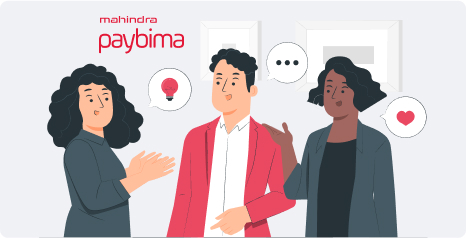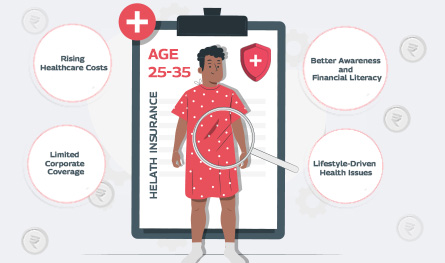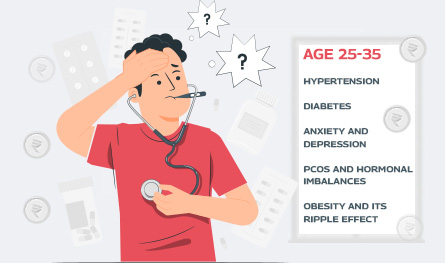Related Articles
 Jan 08, 2025
Jan 08, 2025
Is Varicose Vein surgery covered under the health insurance policy in India
 Health Insurance
Health Insurance
.jpg)
In today's world, health insurance is an essential financial tool for much-needed protection against rising medical expenses. A simple health insurance policy might cover your day-to-day minor medical expenses, but not your extensive medical treatments or emergencies. Super top-up health insurance plans and regular top-up health plans are ideal solutions for those who wish to improve their coverage beyond its basic limits.
These plans are an add-on to your existing insurance which ensures your broader coverage. In this article, we will discuss what super top-up health insurance plans are, how they work, their benefits and the differences between top-up and super top-up policies.
.jpg)
A super top-up health insurance plan is an add-on policy that gives you financial coverage beyond the base insurance coverage. It is a deductible insurance plan, meaning it requires a deductible—a predefined amount that must be paid either from your pockets or via an existing policy, before the super top-up coverage kicks in.
Unlike a regular top-up policy which does not cover expenses in excess of the deductible in a single claim, a health insurance super top-up plan aggregates the total medical expenses in a policy year. The super top-up policy starts to apply only when the combined cost of all claims exceeds the deductible.
To maximise super top-up plans, you need to understand how they work. Here's a step-by-step explanation:
Deductible is a feature of every Health insurance super top-up policy. This is the amount you will pay before the insurance company starts to pay for your expenses. Either you use your existing health policy to meet the deductible or make out-of-pocket payments.
Super top-up plans unlike regular top-up policies apply deductible on total medical expenses incurred during a policy year. Then, once the aggregated cost of all treatment above a minimum cost called the deductible is exceeded, the policy covers the expenses post that.
After the deductible is met, the super top-up plan covers hospitalisation, day-care, pre and post-hospitalisation expenses and other medical expenses as per the policy terms.
Flexible deductible options are provided with these plans to enable policyholders to fine-tune their coverage, based on their existing health insurance or financial capability. Lower premiums usually go in hand with higher deductibles.
Typically, super top-up plans cover expenses related to hospitalisation, pre and post-hospitalisation, daycare treatments and other medical bills as per the terms of the insurer.
With so many advantages, a super top-up health insurance plan is a cost-effective method to supplement your health coverage. Here are some key benefits of super top-up health insurance:
The coverage limits provided by super top-up plans are much higher than the premium you pay when compared to increasing the sum insured of your base policy. For example, you have an existing policy of ₹10 lakhs and instead of upgrading it to ₹20 lakhs, you could add a super top-up plan with a deductible of ₹5 lakhs, saving you big time on premiums.
These plans are particularly useful for dealing with high-cost treatments like surgeries, long-term hospitalisation or treatment for chronic diseases that might exceed your base policy’s sum insured.
Super top-up plans allow you to top up multiple claims in a year, unlike top-up policies. As a result, they are a good option for people who have regular ongoing medical bills or those looking for all-inclusive coverage for the whole family.
Many employees depend on group health insurance from their employers. However, those plans usually come with only limited coverage. Super top-up plans are a supplement to ensure that there is enough protection, without replacing the current cover.
You can pick a deductible depending on your financial capability or your current policy coverage. The premium is lower if your deductible is higher, and that means you are in control of costs.
Maternity benefits, coverage for critical illnesses and pre-existing conditions after a waiting period, subject to the insurer, are also included in super top-up plans.
Top-up and super top-up health insurance plans are designed to increase the benefits of your base health insurance. However, there are major differences between them. Here’s a detailed comparison:
Deductible Application
● Top-Up Insurance: To be applied on each claim separately.
● Super Top-Up Insurance: When applied on an aggregate basis to claims made during the policy year.
Claim Flexibility
● Top-Up Insurance: Best used in single high-value claims.
● Super Top-Up Insurance: Applicable for several claims that in the aggregate are above the stated deductible.
Coverage
● Top-Up Insurance: Refers to cases that are beyond the scope of the deductible per event.
● Super Top-Up Insurance: It covers multiple claims at different times in the year.
Premium
● Top-Up Insurance: Slightly lower premiums.
● Super Top-Up Insurance: The super top-up insurance premiums are slightly high because of the coverage that is offered.
Best For
● Top-Up Insurance: Recommended for people expecting one major claim that they will make.
● Super Top-Up Insurance: Suitable for those people who may have a chance to have several claims within one year.
Let’s assume a deductible of ₹5 lakhs with medical expenses of ₹3 lakhs incurred three times during the year:
● Under a Top-Up Plan: Since no one claim is more than ₹5 lakhs, there will be no payout.
● Under a Super Top-Up Plan: The total cost of ₹9 lakhs will initiate the coverage, which shall provide the coverage over and above the first ₹5 lakhs.
Super top-up plans are better suited to give more financial cover since it is expected that one will have to make more than one claim within a year.
Health insurance super top-up is an add-on policy to the base plan that covers all medical costs exceeding a predefined deductible. It is more comprehensive than a regular top-up plan because it is applied to more than one claim in a policy year.
Medical expenses up to the sum insured are covered by regular health insurance without any deductible. On the other hand, super top-up insurance only kicks in after the deductible is met and covers the high or aggregated medical expenses.
The main advantages are that you get to cover more at a lower cost, protect against multiple claims, have flexibility as regards deductibles, and fill in the gaps of existing insurance policies. These are cost-effective solutions for containing catastrophic healthcare costs.
As per the policy, most super top-up plans do cover pre-existing conditions after a specific waiting period. Documentation of terms and conditions for the insurer is advised.

Paybima Team
Paybima is an Indian insurance aggregator on a mission to make insurance simple for people. Paybima is the Digital arm of the already established and trusted Mahindra Insurance Brokers Ltd., a reputed name in the insurance broking industry with 17 years of experience. Paybima promises you the easy-to-access online platform to buy insurance policies, and also extend their unrelented assistance with all your policy related queries and services.
.png)
When you're planning to take a personal loan, knowing your monthly EMI in advance can help you stay financially prepared. The Muthoot Personal Loan EMI Calculator is a simple and efficient tool that provides instant EMI estimates based on your loan amount, interest rate, and tenure.


Relocating your two-wheeler to a different state needs to follow many procedures. Depending on the duration for which you are moving to the new place, it becomes necessary to transfer your vehicle papers if it is for more than a year. Although tedious, the process of relocating vehicles can become easy if you follow certain tips mentioned in this post. Read on!


In what’s being called a quiet healthcare revolution, India’s young working professionals are reportedly making the most health insurance claims – outpacing even senior citizens. Surprised? So are the insurance providers. Young adults ranging between 25 and 35 years, who are often assumed to be in peak health, are now dominating the charts in health insurance claims by age.


If you think lifestyle-related health issues only show up after 40, think again. Youth no longer guarantees immunity. Today’s 25 - 35 age group is increasingly facing medical issues that only plague older adults. The reason? Long working hours at the desk, deliveries on speed dial, and a social life that rarely includes a decent amount of sleep are some of the reasons for the early onset of medical conditions like diabetes, anxiety, and hypertension.
